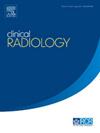Incorporation of transperineal ultrasonography and pelvic electromyography into the real clinical setting for the prediction of postpartum stress urinary incontinence
IF 1.9
3区 医学
Q2 RADIOLOGY, NUCLEAR MEDICINE & MEDICAL IMAGING
引用次数: 0
Abstract
Aim
Risk factors for predicting postpartum stress urinary incontinence (SUI) attract increasingly more attention. Here, we incorporate transperineal ultrasonography (US) and pelvic floor electromyography into the real clinical setting, aiming to evaluate various risk factors comprehensively and objectively and weigh their roles in predicting postpartum SUI.
Materials and methods
A total of 530 subjects were enrolled. SUI was diagnosed using the International Consultation on Incontinence Questionnaire–Short Form. The clinical, ultrasonographic, and myoelectric data of the subjects were collected. Risk factors of postpartum SUI were analysed in this integrated context. The performance of different combined risk factors models was tested and internally verified.
Results
The maternal age, body mass index, hypertension, parity, the bladder neck–symphysis distance during the Valsalva manoeuvre, retrovesical angle during the Valsalva manoeuvre and abnormal fatigue degree of type Ⅱ muscle fibres were independent risk factors of postpartum SUI (P<0.05). Assisted vaginal birth was more associated with SUI than cesarean birth in primipara subgroups by modes of delivery (P=0.040). The combined model of clinical, ultrasonographic, and myoelectric factors showed optimal performance in predicting SUI (C-statistics = 0.771). The efficacy of the combination of clinical and ultrasonographic variables was slightly lower (C-statistics = 0.762, P=0.167). The calibration curves of both models above were well-fitted.
Conclusion
Compared with simple clinical factors, the combination of clinical and sonographic factors significantly increased the odds of predicting postpartum SUI with similar efficacy as the optimal combination of clinical, ultrasonographic, and myoelectric three aspects, which suggested the necessary role of transperineal US examination in SUI.
将经会阴超声和盆腔肌电图结合实际临床环境预测产后应激性尿失禁
目的预测产后应激性尿失禁(SUI)的危险因素越来越受到重视。本研究将经会阴超声(US)和盆底肌电图结合到实际临床环境中,旨在全面客观地评价各种危险因素,并权衡其在预测产后SUI中的作用。材料与方法共入组530例受试者。SUI诊断使用国际咨询失禁问卷-短表格。收集受试者的临床、超声和肌电数据。在此综合背景下分析产后SUI的危险因素。对不同组合风险因素模型的性能进行了测试和内部验证。结果产妇年龄、体重指数、高血压、胎次、Valsalva术时膀胱颈联合距离、Valsalva术时膀胱后角、Ⅱ型肌纤维异常疲劳程度是产后SUI的独立危险因素(P<0.05)。在初产妇亚组中,辅助阴道分娩与SUI的相关性高于剖宫产(P=0.040)。临床、超声和肌电因素联合模型预测SUI的效果最佳(C-statistics = 0.771)。临床指标与超声指标联合使用的疗效稍低(C-statistics = 0.762, P=0.167)。上述两种模型的标定曲线拟合良好。结论与单纯的临床因素相比,临床与超声因素联合预测产后SUI的几率显著提高,且与临床、超声、肌电三方面最佳联合预测的效果相近,提示经会阴超声检查在SUI中的必要作用。
本文章由计算机程序翻译,如有差异,请以英文原文为准。
求助全文
约1分钟内获得全文
求助全文
来源期刊

Clinical radiology
医学-核医学
CiteScore
4.70
自引率
3.80%
发文量
528
审稿时长
76 days
期刊介绍:
Clinical Radiology is published by Elsevier on behalf of The Royal College of Radiologists. Clinical Radiology is an International Journal bringing you original research, editorials and review articles on all aspects of diagnostic imaging, including:
• Computed tomography
• Magnetic resonance imaging
• Ultrasonography
• Digital radiology
• Interventional radiology
• Radiography
• Nuclear medicine
Papers on radiological protection, quality assurance, audit in radiology and matters relating to radiological training and education are also included. In addition, each issue contains correspondence, book reviews and notices of forthcoming events.
 求助内容:
求助内容: 应助结果提醒方式:
应助结果提醒方式:


